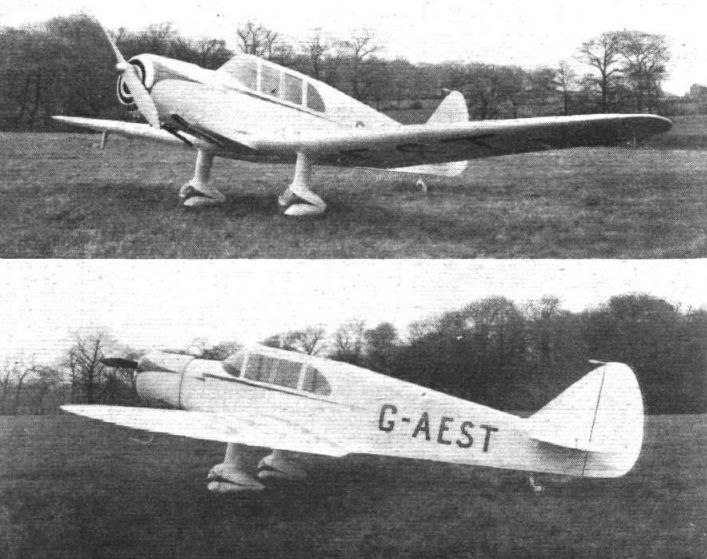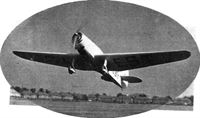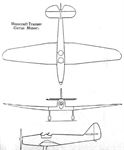Flight, May 1937
PRACTICAL IDEAL
An Interesting Cabin Monoplane from Lancashire: Good Speed Range and Field of View
SOME time ago it was learnt that a firm in Chorley (Lancashire) was going ahead with the construction of a light aeroplane from which an exceptional range of performance was expected. Very sensibly, the manufacturers - Moss Brothers Aircraft, Ltd. - did not wish to say anything about their production until the machine had actually flown and given its sponsors some idea of what it would do. Now that the Mess monoplane has been tested and is ready for Martlesham it is possible to give a few details of the machine, and although performance figures are not yet available, we learn that the cruising speed is rather better than 120 m.p.h.
The original idea of the company was to produce a cabin machine at a reasonable price which would cruise at something well-over 100 m.p.h., yet land very slowly and provide as good a view for the pilot as is possible in a tractor machine. Initial trials have shown that the ideals have been largely achieved.
In conformity with modern ideas, the machine is a low-wing, ply-covered monoplane with a single-spar wing and trailing edge flaps. The two occupants are seated in tandem with ample luggage space behind them. It is powered with a Pobjoy Niagara III of 95 h.p., and, carrying a useful load of 400 lb., the range should be 400-500 miles. A cantilever oleo-pneumatic undercarriage is fitted with the usual low-pressure wheels and brakes. The provisional price is ?750.
The company concerned in this venture is an interesting one, since the five directors are all brothers and each one of them has had practical flying experience; two, in fact, have their "B" licences and Instructor's Certificate, and one, the eldest, holds Argentine, American and British licences with nine years' flying experience in these countries. Consequently, there should be little doubt that the machine will be practical in both design and performance. Their family business is, in fact, that of varnish manufacture, carried on by H. S. Moss and Co.
The available dimensions and other figures for the Moss monoplane are as follows:
Span 34ft., length 23ft., height 7ft., weight empty 860 lb., weight loaded 1,260 lb., fuel capacity 21 gallons, oil capacity 1 3/4 gallons.
Показать полностьюShow all
Flight, March 1938
British light aircraft
MOSS
THE Moss monoplane, which first made its public appearance in early summer of last year, may be described as a machine designed by, and for, the enthusiastic amateur. Actually, five brothers, each a pilot, may be said to have had some part in working out the specification, and the machine may, consequently, be expected to satisfy at least some of the ideals of some of the prospective pilots in this country.
The machine is a cantilever low-wing machine with the two occupants arranged in tandem, and it is to some extent unique in that it has been designed to be flown from the front seat whether or not a passenger is carried. Since the front seat is almost directly over the leading edge, the pilot’s view is exceptionally good. The original version of the machine was arranged with full cockpit enclosure, but later versions may be of the more conventional separate-cockpit design, according to the demands of the purchaser. The engine at present fitted is a Pobjoy Niagara III, which gives it a remarkably wide speed range. Flaps are, of course, fitted, and these are of the split type and are mechanically operated. The structure in general is quite straightforward with a single main box spar for the wing and a ply-covered box structure for the fuselage.
SPECIFICATION: Span, 34ft.; length, 23ft. 3in.; all-up weight, 1,400 lb.; weight empty, 950 lb.; maximum speed, 130 m.p.h.; cruising speed, 115 m.p.h.; landing speed, 38 m.p.h.; initial rate of climb, 800ft. / min.; range, 450 miles; price, £750. Makers: Moss Brothers Aircraft. Ltd.. Charley. Lancs.
Показать полностьюShow all
Flight, October 1938
MODERN CONVENTION
Present Light Aircraft Tendencies and the Moss Prototype Discussed : Trainer Development : A Worthy Compromise
by H. A. TAYLOR
NECESSITY seems, in the aircraft world, to have been the mother of the cantilever monoplane. In spite of the attractive features of what was once known as the conventional aeroplane layout, efficiency has demanded the development of the monoplane type and, in particular, of the low- or mid-wing design. And the trainers, slowly but inevitably, have had to follow suit.
Not that with a good design the monoplane cannot be a better all-round machine from every point of view than the biplane; it is merely that constructors have had a little more experience of the latter. It is possible for a good low-wing monoplane to have certain safe and easy characteristics which cannot be obtained in a biplane. A safe, straightforward stall, an exceptionally easy landing and an excellent range of view for the pilot are essentially the features of to-day’s type.
Exactly how the accommodation should be laid out is still a matter for argument. The side-by-side seating arrangement has quite pronounced advantages, but a fair proportion of experienced instructors still believe that a pupil may be more satisfactorily taught when he is, so to speak, alone with a set of duplicated controls. Furthermore, the tandem seating arrangement can provide one of the occupants, at least, with a field of view which can rarely be obtained in a side-by-side seater. This field, however, is only available to its fullest extent for the occupant of the front seat, and one important manufacturer has laid out his latest private-cum-trainer type with the pilot in front and overlooking the leading edge.
Provided that a suitable wing section is chosen, such an arrangement provides few difficulties with a fairly lightly loaded machine, and it is curious that, until comparatively recently, no designer seems to have thought seriously of providing this type of layout. It says a good deal for the essentially common-sense features of the front-drive tandem-seater low-wing arrangement that another firm as long ago as 1936 decided that this was the best compromise in the development of an ideal private-owner type. Early in 1937 the five brothers Moss, all pilots, produced their own idea of what an economical private type should be. The machine was described in Flight of May 17 of that year, and only misfortune (and an hour or two) prevented Mr. W. H. Moss from flying in the 1937 King’s Cup and, with an open two-seater machine, in the same race this year. Meanwhile, the Mosscraft, in its two forms, has, however, been seen about quite a lot.
Certainly the business of flying from the front seat in any aeroplane, even a well strutted biplane, gives one a remarkable feeling of being in full control of any situation. In a low-wing monoplane the whole world, except that immediately below the fuselage, seems to be in full and continuous view. This, of course, is an illusion, and only goes to suggest how bad the view must be in the majority of machines.
The major difficulty seems to be to provide the same degree of visual and physical comfort for the occupant of the rear seat. In the Moss, with quite an insignificant screen, it is comfortably possible to fly without helmet or goggles in front, but at the rear there is a chilling draught which arrives from behind - evidently the result of some complicated turbulence aft of the front screen. None of this mattered in the case of the original Mosscraft, which had a cabin top, but the sports model can also be considered as the test type for a trainer which is now in course of construction. Various experiments will he carried out until almost equal comfort can be given to both the occupants of this new machine, which should be flying early next year.
Otherwise - and except for minor fuselage differences, as a result of experience - the characteristics of the sports type, which I recently had a chance of flying, may be considered to be those which will appear later in the trainer. These characteristics are markedly pleasant from all points of view, and show that real stability and safety can be combined with adequate manoeuvrability. The wing section is a modified R.A.F. 34, with a more or less stationary centre of pressure, so that there is little change of trim when the machine is flown solo or two up. In the prototype no trimming gear has been considered necessary, and this, in the form of a spring-loading device, will only be useful to provide really accurate hands-off trim on long journeys. As it is, with a passenger, the machine has a very slight tendency to climb when left to its own devices. There is absolute stability in all axes, and, in common with some other modern aeroplanes, it can he flown accurately on the stick alone - up to the point of really steep turns.
Safe Stall
Although the Mosscraft has been stressed for aerobatics (it now has a C. of A. in the normal category), it has not yet been put through spinning tests. This will be done, with a tail parachute, in a few weeks, but apparently Mr. W. H. Moss has been unable, using normally exaggerated control movements, to produce a spin. With the depth of fuselage and amount of rudder below the tail plane there is no reason to suppose that, if started, the spin will not be immediately corrected. I was satisfied to try the stall in various flap positions, with the rudder held more or less central. Even at an indicated speed of about 40 m.p.h. (or 37 with flaps down) the machine remains perfectly level, and there is still some aileron control. Only when the stick is brought right back and held there does the true stall develop. This results in a sudden but not particularly pronounced change in the fore and aft attitude, and one wing drops. The fact that the Mosscraft is regularly flown out of and into a microscopic and far-from-level field next door to the factory, which is part of the Moss varnish works, proves that there is nothing wrong either with the take-off or with the approach characteristics.
Accurate spot-landings are made easy by the fact that the mechanically operated flaps have a wide variety of positions. One can make the initial part of the approach on half the movement, retaining some, or all, of the rest of this movement to get rid of the final hundred feet or so. With the flaps in the fully down position the approach is extraordinarily steep, and it might be advisable for instructors to discourage their full use until the more advanced solo stages. Except at the Reserve schools very little experience has been obtained in ab initio instruction with flapped aeroplanes. There is ample time, however, to make a perfectly normal landing from an approach speed of, say, 55 or 60 m.p.h. with the flaps fully down, but the change of attitude from the glide to three-point landing is sufficiently pronounced to demand a fair degree of accuracy in height judgment. Up to an angle of 60 degrees the effect of the flaps is sober and helpful, and, when using the different positions to stretch or shorten the glide only the first 20 degrees or so changes the lift characteristics sufficiently to cause a slight less, or apparent loss, of height.
Sideslipping
A good feature of the Mosscraft is that, contrary to experience with most machines of similar type, it can be sideslipped properly. If too much bank is not attempted a slip can be held accurately at an air speed of 60 m.p.h., and the control positions are more or less immutable. Experiments at a safe height with the flaps up or down showed that there was no likelihood of tail control washout in normal attitudes and at reasonable speeds. The Mosscraft, in fact, behaves like any good trainer in this manoeuvre. Incidentally, the machine in its present form has Hurricane-type (or harmonium) rudder pedals, complete with built-in heel-rests. One does not appear to have quite the requisite degree of "feel" with these (feet are unfeeling enough as it is), and it is probable that the production trainer will be more normally equipped.
This trainer will be fitted with a Cirrus Minor, but the only performance change, in comparison with that of the Pobjoy-engined version, is likely to be a slightly less rapid take-off; with the geared Pobjoy this is remarkably short. The cruising speed will probably be almost the same. The indication with the present model, at 3,300 r.p.m., is 110-115 m.p.h., while the maximum seems to be in the region of 125 m.p.h.
There is nothing at all unconventional about the construction, which is of the stressed wooden skin variety, only the ailerons, rudder and elevator being fabric-covered. The wing has a single main box spar with an auxiliary rear spar, and, though it does not fold, the two outer sections can be detached simply and quickly for transport or storage purposes.
THE MOSSCRAFT MONOPLANE.
Pobjoy Niagara III(95 h.p.) in Sports and Cabin versions; Cirrus Minor (90 h.p.) jn Trainer.
Cabin Type. Trainer Type.
Span 34ft. 34ft.
Length 23ft. 3in. 23ft. 3in.
Weight empty 880 lb. 880 lb.
All-up weight 1,400 lb. 1,400 lb.
Wing loading 9.10 lb./sq. ft. 9.10 Ib./sq. ft.
Max. speed 130 m.p.h. 127 m.p.h.
Cruising speed 120 m.p.h. 110 m.p.h.
Stalling speed (flaps down) 37 m.p.h. 37 m.p.h.
Initial rate of climb 700 ft./min. 640 ft./min.
Service ceiling 13,000ft. 13,000 ft.
Cruising range 500 miles 550 miles
Price £750 £605
Makers: Moss Brothers Aircraft, Ltd., Chorley, Lancs.
Показать полностьюShow all
Flight, October 1938
British Sport and Training types
MOSS
NEARLY two years ago the five brothers Moss produced their first machine, which was a tandem two-seater cabin monoplane fitted with a Pobjoy Niagara engine. With this they were probably the first to demonstrate the advantages of front-seat flying with the tandem arrangement. Since that time a sports model has been produced, and now work is going on with the development of a trainer type. This will be fitted with a Cirrus Minor engine, while the others will still be available with Niagara III engines.
In the design of all three an attempt has been made to compromise to the best possible advantage in the development of a suitable machine for the owner or the club. The wooden construction is simple, and the machine has a very fair performance with good and safe flying characteristics.
In trainer form the Mosscraft will be an open tandem two-seater, and once again the pupil (or pilot) will fly from the front seat, whence there is an exceptional range of view. The structure is stressed ply, with a single main spar, auxiliary rear spar, and box-type fuselage. The wings do not fold, but the outer sections are each attached by two bolts so that they can be quickly removed when necessary. As in the case of the prototype, the trainer will have mechanically operated split trailing-edge flaps in which the angle can be varied within wide limits.
The details below are for the trainer type, and it is sufficient to say that in cabin form the Mosscraft has a maximum speed of 130 m.p.h. and a utilising speed of 120 m.p.h., while the sports type has a maximum of 135 m.p.h. and a cruising speed of 122 m.p.h. The price of the cabin version is L750 and that of the sports type L695.
Mosscraft data:- Span, 34ft.; length. 23ft. 3in.; all-up weight, 1,400 lb.; weight empty, 880 lb.; wing-loading 9.10 lb./sq. ft.; power-loading, 16.7 Ib./h.p.; maximum speed, 127 m.p.h.; cruising speed, 110 m.p.h.; landing speed (flaps down), 36 m.p.h.; rate of climb, 640 ft./min.; service ceiling, 13,000ft.; cruising range, 560 miles; and price, L695.
Makers: - Moss Brothers Aircraft. Ltd., Charley, Lancs (Chorley 2145).
Показать полностьюShow all
Flight, September 1939
To-day's Light Aeroplanes
MOSSCRAFT
FIRST of the machines to have a “front drive” seating arrangement, the Mosscraft, which originally appeared three years ago, is now being made in trainer or cabin form with a Cirrus Minor engine. Pobjoy-engined models are now only made to order. It is a low wing monoplane of straightforward construction with split flaps and tandem seating, built by a firm of which five brothers, all pilots, are the directors. An interesting little point of the trainer is that, in order to offer easy entrance with close fitting, and consequently comfortable, cockpit openings, the entire decking over the two separate seats hinges over sideways with the screens.
Span 34ft.
Length 23ft. 3in.
All-up weight 1,400 lb.
Max speed 120 m.p.h
Cruising speed 105 m.p.h.
Stalling speed (flaps down) 36 m.p.h
Initial rate of climb 850 ft./min.
Range 350 miles.
Price /690.
Makers: Moss Brothers Aircraft. Ltd.. Chorley, Lancs.
Показать полностьюShow all
Flight, November 1939
Britain's Civil Aircraft
MOSSCRAFT
THE Mosscraft low-wing monoplane trainer was the first of the machines in which the pilot was seated in front. Production of the type is at present being confined to a batch laid down before the war. These machines are powered with the Cirrus Minor engine and have the following characteristics: Span, 34ft. ; length, 23ft. 3in.; all-up weight, 1,400 lb.; maximum speed, 120 m.p.h.; cruising speed, 105 m.p.h.; stalling speed (flaps down), 36 m.p.h.; initial rate of climb, 8.50ft./min.; range, 350 miles.
Moss Brothers Aircraft. Ltd., Chorley, Lancs.
Показать полностьюShow all












